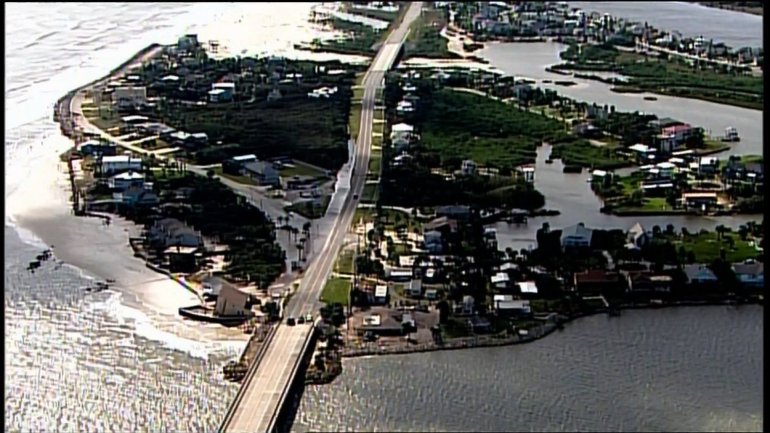(CNN) — Matthew, the deadly storm that’s spread misery from the Caribbean to the Carolinas, is no longer a hurricane. But it’s still packing a powerful punch.
The storm whipped North Carolina Sunday morning, causing “record-breaking” flooding and blowing powerful winds after killing at least 15 people in four states.
Matthew was 60 miles southeast of Cape Hatteras, North Carolina, at mid-morning Sunday and heading east-northeast at about 14 mph farther into the Atlantic Ocean.
The latest
• The National Hurricane Center says Matthew is no longer a hurricane and is now considered a post-tropical cyclone. Despite its new title, it’s still packing maximum sustained winds of 75 mph (120 kph) — the same as a Category 1 hurricane, forecasters said.

Aerial images displaying the aftermath of Hurricane Matthew in Jacksonville, Fl on Oct 8. 201
Matthew’s only change is in its “core structure,” hence the change to a cyclone, CNN meteorologist Allison Chinchar said. However, she warned, the change in name does not mean it’s any less dangerous.
“It’s still packing the same hurricane-force winds and potential for flooding and is still as deadly as a hurricane,” she said.
• Matthew killed at least seven people in North Carolina, four in Florida, three in Georgia and one in South Carolina, authorities said.
Nearly 900 people have been rescued in North Carolina after Matthew battered the eastern part of the state. That number includes 562 rescued in Cumberland County alone, Gov. Pat McCrory said Sunday. The number is expected to rise as people remain trapped in their homes, authorities said. Four people remain missing in Cumberland County.
• Matthew killed one person in South Carolina, Gov. Nikki Haley said Sunday. The person was in a vehicle trying to cross flooded roads in the Florence area and got swept away Saturday, she said.
• City officials in Norfolk and Virginia Beach, Virginia, declared a local state of emergency. Officials in both cities issued statements urging citizens to stay off roads and opened emergency shelters.
• The storm has killed hundreds in the Caribbean, almost entirely in Haiti. More than 330 people died in Haiti, according to the nation’s Civil Protection Service.
Others reported much higher deaths. A count by Reuters, based on information from local civil protection officials, puts the death toll in Haiti at well over 800. Four deaths were reported in the Dominican Republic and one in St. Vincent and the Grenadines.
Out to sea
Although it’s slowly moving out into the Atlantic, Matthew will continue to lash eastern North Carolina with heavy rainfall and strong winds Sunday, and as a result massive flooding will continue to plague that part of the state, CNN meteorologist Jennifer Varian said.
But these will likely be the storm’s last gasps. Forecasters say Matthew will die out in the Atlantic in about 48 hours, meaning it won’t have a chance to loop back and hit land again as previously predicted.
“It’s going to die off too quickly,” said Chinchar. “It’s going to go to the east and die off.”
Flooding in Georgia, South Carolina
The storm left more than 2 million utility customers without power Saturday night in South Carolina (833,000), Florida (673,000), North Carolina (457,000) and Georgia (276,000).
In the coastal Georgia city of Savannah, Sue Alice Walker, 85, said she was sleeping in her house when she awoke to find 3 inches of water flowing inside.
“First I saw it in the living room, then in the kitchen, and then last it came in my son’s room,” she told CNN’s Sara Ganim, adding that she spent the rest of the night and much of Saturday morning mopping and shoveling the water into buckets.
Storm surges sent water spilling into Myrtle Beach’s streets Saturday before the storm’s center arrived, video posted by CNN affiliate WPDE showed.
“I’m going to ask for patience. … Do not plan to go home,” Haley said, asserting that driving conditions weren’t safe.
A Tybee Island resident described the moment when the storm hit his home.
“As nightfall hit the winds increased and it was just constant just constant wind,” the unidentified man told CNN. “All of our windows got immediately blown out. I lost power. All the fencing around my home went down like matchsticks.”
Florida
In Florida, Matthew left a trail of destruction.
Water from the storm rushed through streets, making roadways look more like rivers in parts of Jacksonville, Merritt Island, Fleming Island and other Florida communities.
Florida struggled with the rising water, rain and strong winds as meteorologists said the storm surge was more than 4 feet in some areas.
Jacksonville was not battered as heavily as initially feared. But several communities nearby received extensive damage with water surging down some streets, and massive trees toppled over.
Part of the Jacksonville Beach Pier washed away Friday morning, according to CNN affiliate WFOX/WJAX. The original pier was washed away during Hurricane Floyd and rebuilt a few years later, the station said.
CNN’s Sara Ganim, Derek Van Dam, Nick Valencia, Rolando Zenteno, Dave Hennen, Michael Guy, Susanna Capelouto, Joe Sutton, Judson Jones and Stephanie Elam contributed to this report.
The-CNN-Wire



























